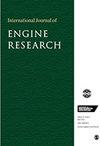确定管道式燃油喷射中喷射管对准的公差要求
IF 2.1
4区 工程技术
Q2 ENGINEERING, MECHANICAL
引用次数: 0
摘要
多项管道式燃油喷射(DFI)研究都强调,为了达到最佳效果,管道轴线与相应喷嘴轴线的对准精度非常重要,因为不对准会对该方法的性能产生不利影响。精确对准的需要可能会导致更严格的公差,从而增加制造的复杂性。本研究系统地探讨了水平、垂直和旋转不对准的情况,分析了它们各自对 DFI 性能的影响。管道入口平面的垂直和水平偏差分别为管道直径的 6.25%、12.5% 和 25.0%,相当于 0.125、0.25 和 0.5 毫米。旋转偏差设定为 1°、2° 和 4°,分别相当于管道入口平面直径的 3.65%、7.30% 和 14.6%。调查得出了喷射管道对齐的公差限值,并强调了由于燃烧室内漩涡和挤压的相互作用,错位方向对排放的影响。结果表明,相对于几何对齐位置,对齐的公差限制在 4° 和 0.5 毫米之内。如果旋转偏差超过 4° 或水平方向偏差超过 0.5 毫米,则不再能观察到使用这种方法减少烟尘的有益效果。这些发现有助于人们了解如何优化 DFI,使压燃式发动机的燃烧更清洁、更高效。本文章由计算机程序翻译,如有差异,请以英文原文为准。
Determining tolerance requirements for spray-duct alignment in ducted fuel injection
Several ducted fuel injection (DFI) studies have highlighted the importance of accuracy in aligning the duct axis with that of its corresponding spray for optimal effectiveness, as misalignment adversely impacts the method’s performance. The need for accurate alignment could lead to added manufacturing complexity via tighter tolerances. This study systematically explores cases of horizontal, vertical, and rotational misalignment, analyzing their respective effects on DFI performance. Vertical and horizontal misalignments at the duct inlet plane were varied at magnitudes of 6.25%, 12.5%, and 25.0% of the duct diameter, corresponding to 0.125, 0.25, and 0.5 mm, respectively. Rotational misalignments were set at 1°, 2°, and 4°, corresponding to 3.65%, 7.30%, and 14.6%, respectively, of the duct diameter at its inlet plane. The investigation yields spray-duct alignment tolerance limits and highlights the influence of misalignment direction on emissions due to the interactions with swirl and squish inside the combustion chamber. The results indicate that the tolerance limits for the alignment are within 4° and 0.5 mm relative to the geometrically aligned position. If the misalignment exceeds 4°of rotation or 0.5 mm in the horizontal direction, the beneficial effects on soot reduction using this method are no longer observed. The findings contribute to an understanding that can be used to optimize DFI for cleaner and more efficient combustion in compression-ignition engines.
求助全文
通过发布文献求助,成功后即可免费获取论文全文。
去求助
来源期刊

International Journal of Engine Research
工程技术-工程:机械
CiteScore
6.50
自引率
16.00%
发文量
130
审稿时长
>12 weeks
期刊介绍:
The International Journal of Engine Research publishes high quality papers on experimental and analytical studies of engine technology.
 求助内容:
求助内容: 应助结果提醒方式:
应助结果提醒方式:


